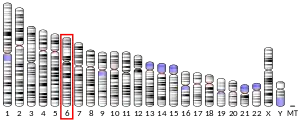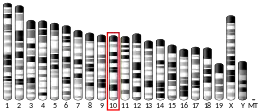AKAP12
A-kinase anchor protein 12, aka AKAP250, is an enzyme that in humans is encoded by the AKAP12 gene.[5][6]
Function
The A-kinase anchor proteins (AKAPs) are a group of structurally diverse proteins, which have the common function of binding to the regulatory subunit of protein kinase A (PKA) and confining the holoenzyme to discrete locations within the cell. This gene encodes a member of the AKAP family. The encoded protein is expressed in endothelial cells, cultured fibroblasts, and osteosarcoma cells. It associates with protein kinase A and C and phosphatase, and serves as a scaffold protein in signal transduction. This protein and RII PKA colocalize at the cell periphery. This protein is a cell growth-related protein. Antibodies to this protein can be produced by patients with myasthenia gravis. Alternative splicing of this gene results in two transcript variants encoding different isoforms.[6]
Interactions
AKAP12 has been shown to interact with Beta-2 adrenergic receptor.[7][8]
References
- GRCh38: Ensembl release 89: ENSG00000131016 - Ensembl, May 2017
- GRCm38: Ensembl release 89: ENSMUSG00000038587 - Ensembl, May 2017
- "Human PubMed Reference:". National Center for Biotechnology Information, U.S. National Library of Medicine.
- "Mouse PubMed Reference:". National Center for Biotechnology Information, U.S. National Library of Medicine.
- Nauert JB, Klauck TM, Langeberg LK, Scott JD (Mar 1997). "Gravin, an autoantigen recognized by serum from myasthenia gravis patients, is a kinase scaffold protein". Curr. Biol. 7 (1): 52–62. doi:10.1016/S0960-9822(06)00027-3. PMID 9000000. S2CID 18843778.
- "Entrez Gene: AKAP12 A kinase (PRKA) anchor protein (gravin) 12".
- Fan G, Shumay E, Wang H, Malbon CC (Jun 2001). "The scaffold protein gravin (cAMP-dependent protein kinase-anchoring protein 250) binds the beta 2-adrenergic receptor via the receptor cytoplasmic Arg-329 to Leu-413 domain and provides a mobile scaffold during desensitization". J. Biol. Chem. 276 (26): 24005–14. doi:10.1074/jbc.M011199200. PMID 11309381.
- Shih M, Lin F, Scott JD, Wang HY, Malbon CC (Jan 1999). "Dynamic complexes of beta2-adrenergic receptors with protein kinases and phosphatases and the role of gravin". J. Biol. Chem. 274 (3): 1588–95. doi:10.1074/jbc.274.3.1588. PMID 9880537.
External links
- Human AKAP12 genome location and AKAP12 gene details page in the UCSC Genome Browser.
Further reading
- Lester LB, Scott JD (1997). "Anchoring and scaffold proteins for kinases and phosphatases". Recent Prog. Horm. Res. 52: 409–29, discussion 429–30. PMID 9238861.
- Michel JJ, Scott JD (2002). "AKAP mediated signal transduction". Annu. Rev. Pharmacol. Toxicol. 42: 235–57. doi:10.1146/annurev.pharmtox.42.083101.135801. PMID 11807172.
- Yildirim M, Paydas S, Tanriverdi K, Seydaoglu G, Disel U, Yavuz S (2007). "Gravin gene expression in acute leukaemias: clinical importance and review of the literature". Leuk. Lymphoma. 48 (6): 1167–72. doi:10.1080/10428190701377055. PMID 17577780. S2CID 35975874.
- Gordon T, Grove B, Loftus JC, O'Toole T, McMillan R, Lindstrom J, Ginsberg MH (1992). "Molecular cloning and preliminary characterization of a novel cytoplasmic antigen recognized by myasthenia gravis sera". J. Clin. Invest. 90 (3): 992–9. doi:10.1172/JCI115976. PMC 329955. PMID 1522245.
- Sato N, Kokame K, Shimokado K, Kato H, Miyata T (1998). "Changes of gene expression by lysophosphatidylcholine in vascular endothelial cells: 12 up-regulated distinct genes including 5 cell growth-related, 3 thrombosis-related, and 4 others". J. Biochem. 123 (6): 1119–26. doi:10.1093/oxfordjournals.jbchem.a022051. PMID 9604001.
- Shih M, Lin F, Scott JD, Wang HY, Malbon CC (1999). "Dynamic complexes of beta2-adrenergic receptors with protein kinases and phosphatases and the role of gravin". J. Biol. Chem. 274 (3): 1588–95. doi:10.1074/jbc.274.3.1588. PMID 9880537.
- Lin F, Wang Hy, Malbon CC (2000). "Gravin-mediated formation of signaling complexes in beta 2-adrenergic receptor desensitization and resensitization". J. Biol. Chem. 275 (25): 19025–34. doi:10.1074/jbc.275.25.19025. PMID 10858453.
- Fan G, Shumay E, Wang H, Malbon CC (2001). "The scaffold protein gravin (cAMP-dependent protein kinase-anchoring protein 250) binds the beta 2-adrenergic receptor via the receptor cytoplasmic Arg-329 to Leu-413 domain and provides a mobile scaffold during desensitization". J. Biol. Chem. 276 (26): 24005–14. doi:10.1074/jbc.M011199200. PMID 11309381.
- Grove BD, Bruchey AK (2001). "Intracellular distribution of gravin, a PKA and PKC binding protein, in vascular endothelial cells". J. Vasc. Res. 38 (2): 163–75. doi:10.1159/000051043. PMID 11316952. S2CID 6002979.
- Sasaki H, Kunimatsu M, Fujii Y, Yamakawa Y, Fukai I, Kiriyama M, Nonaka M, Sasaki M (2001). "Autoantibody to gravin is expressed more strongly in younger and nonthymomatous patients with myasthenia gravis". Surg. Today. 31 (11): 1036–7. doi:10.1007/s005950170020. PMID 11766078. S2CID 22167880.
- Piontek J, Brandt R (2003). "Differential and regulated binding of cAMP-dependent protein kinase and protein kinase C isoenzymes to gravin in human model neurons: Evidence that gravin provides a dynamic platform for the localization for kinases during neuronal development". J. Biol. Chem. 278 (40): 38970–9. doi:10.1074/jbc.M306749200. PMID 12857743.
- Tao J, Wang HY, Malbon CC (2003). "Protein kinase A regulates AKAP250 (gravin) scaffold binding to the beta2-adrenergic receptor". EMBO J. 22 (24): 6419–29. doi:10.1093/emboj/cdg628. PMC 291823. PMID 14657015.
- Choi MC, Jong HS, Kim TY, Song SH, Lee DS, Lee JW, Kim TY, Kim NK, Bang YJ (2004). "AKAP12/Gravin is inactivated by epigenetic mechanism in human gastric carcinoma and shows growth suppressor activity". Oncogene. 23 (42): 7095–103. doi:10.1038/sj.onc.1207932. PMID 15258566.
- Ballif BA, Villén J, Beausoleil SA, Schwartz D, Gygi SP (2004). "Phosphoproteomic analysis of the developing mouse brain". Mol. Cell. Proteomics. 3 (11): 1093–101. doi:10.1074/mcp.M400085-MCP200. PMID 15345747.
- Streb JW, Miano JM (2005). "AKAP12alpha, an atypical serum response factor-dependent target gene". J. Biol. Chem. 280 (6): 4125–34. doi:10.1074/jbc.M412466200. PMID 15590635.
- Streb JW, Miano JM (2005). "Cross-species sequence analysis reveals multiple charged residue-rich domains that regulate nuclear/cytoplasmic partitioning and membrane localization of a kinase anchoring protein 12 (SSeCKS/Gravin)". J. Biol. Chem. 280 (30): 28007–14. doi:10.1074/jbc.M414017200. PMID 15923193.




